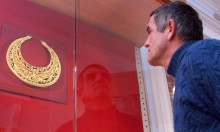Ukrainian exhibition “The Crimea – Gold and Secrets of the Black Sea” has ended long ago at the Dutch Allard Pierson Museum. The exhibits loaned by the Museum of Historical Treasures of Ukraine have returned home long ago. Meanwhile, the fate of the exhibits taken from the collections of four Crimean museums will be decided by an Amsterdam court. Why has it refrained to immediately return these pieces either to the Crimean museums or to Ukraine which designated the National Museum of History as the custodian of the collection for the duration of the peninsula’s annexation? Museum workers explained before that the museum would get in trouble anyway, either with the Ukrainian authorities or with the Russian-Crimean ones. Resolving this conflict, including all related financial issues, is now the responsibility of the competent institution in Amsterdam.
So, the court will ascertain the truth in this case. The trial formally started on January 21. Actually, no hearing was held on that day, which saw Ukraine’s representative submitting a request for our nation’s admission as party to the proceedings, which was initiated by the Crimean museums when they filed a lawsuit against the Allard Pierson Museum. A similar petition was filed on behalf of the Netherlands. This fact is considered a positive development by the interagency working group on the return of the Crimean treasures, for such a request confirms that the Netherlands believe the Crimean exhibits to be Ukrainian property. The Amsterdam court now has two months to decide whether to admit Ukraine and the Netherlands as parties to the proceedings.
Deputy chairperson of the interagency group, head of the government representation in international and foreign courts department at the Ministry of Justice of Ukraine Olha Kostyshyna said that the Crimean museums were not trying to have the dispute settled amicably or out of the court: “Having retained a Dutch legal counsel, whose services, by the way, are quite expensive, they have taken a proactive stance intending to resolve the dispute exclusively through the Dutch court. Ukraine has retained a legal counsel as well, who advised us on a strategy to protect the public interests, which we have jointly developed and approved at a meeting of the interagency working group. Unfortunately, we may not disclose it, because it is confidential, but the strategy involves participation in this proceeding as well.”
The Ukrainian side will meanwhile keep trying to achieve an out-of-court settlement, even with the Crimean plaintiffs having refused to go along this path. Kostyshyna explained that contractual relationships between the museums and exhibition agreements were subject to the substantive law of Ukraine, and all disputes should have been settled before the international commercial court of the Chamber of Commerce of Ukraine, and definitely not before the competent court in Amsterdam. Presumably, Ukrainian arbitration courts would favor the Ukrainian side. However, unfortunately, Ukraine has to prove that it is in the right. Officials agree that this case is a unique one, even for international legal practice, for annexations are uncommon in the 21st century. Museum workers, meanwhile, keep their fingers crossed in hope to see everything come out right and this museum detective to have a good end. Director of the Center of Monuments Studies at the National Academy of Sciences of Ukraine Olena Tytova added that the Crimean artifacts were interesting not only because they were of high monetary and historical value, but also because they could motivate further scientific and archaeological research. After all, the artifacts that originally went to an exhibition in Germany, and then moved to the Netherlands, were uncovered at the sites of Ancient Greek cities and settlements and Late Scythian and Gothic cemeteries quite recently – in the early 2000s.







